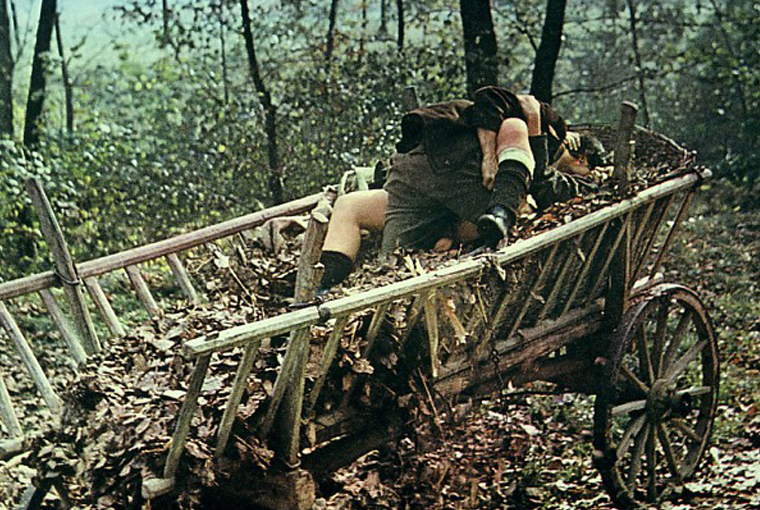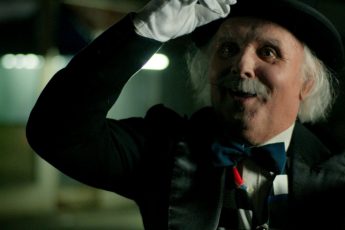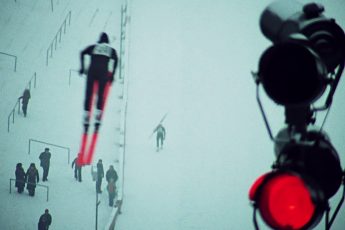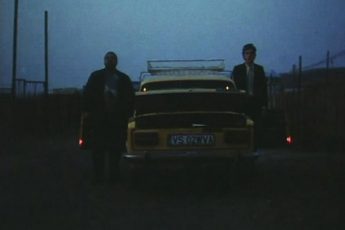The Vision of Živojin Pavlović’s Drastic Image
Živojin Pavlović’s Red Wheat (Rdeče klasje, 1970)
Vol. 44 (August 2014) by Andrej Šprah
Zivojin Pavlović (15 April 1933 – 29 November 1998) is one of the most prominent auteurs to have marked Serbian, Slovenian, Yugoslav and world cinema. Pavlović is important not only as a filmmaker (and writer), but also as an author of a series of exceptionally incisive and lucid critical, journalistic and theoretical texts, collected in numerous books among which I should mention at least Devil’s Cinema: Essays and Conversations and On the Disgusting. The filmography of this eminent filmmaker, who directed thirteen feature films, six short films and a TV series, can be divided into at least two equally important tendencies. Many of his most important works are about people in economic hardship – especially The Rats are Awakening (1967) and When I Am Dead and Pale (1968). In his other, no less representative films, he often focuses on people’s reactions to extreme situations of war and revolution, as well as on the dilemmas that people have to deal with when facing the differences between their own interpretation of revolutionary ideals and their actual realization in everyday reality: The Ambush (1969), Red Wheat (1970), Manhunt (1977), See You in the Next War (1980).
In addition to the “multi-layered” nature of Pavlović’s creative work, it is important to stress the split nature of his work in the film industry, which can be examined from the viewpoint of two national cinemas of the former Yugoslavia – the Serbian and the Slovenian one. He made four feature films in Slovenia or with Slovenian help – starting with The Enemy in 1965, followed by Red Wheat in 1970, The Flight of Dead Bird in 1973 and See You in the Next War in 1980, as well as a series of unfinished projects. The Slovenian share in Pavlović’s work is not only notable for its quality but also because Pavlović received support from Slovenia when he was threatened by political persecution. According to Nebojša Pajkić (one of his close scriptwriting collaborators), “without Slovenia, he would never have been able to slip from the clenches of the State Security Administration and the incomprehensible communist manoeuvring”. It is not surprising therefore that in his reflections on his filmmaking, he often defined himself as a director of both Slovenian and Serbian cinema.1
Pavlović’s work formally ended with the disintegration of Yugoslavia. But historically, it can by no means be reduced to six strictly divided “national” cinemas, forcefully connected by the fetters of the federal yoke, but should rather be related to the activities of an open interaction in the flow of creative, ideal, cultural and social energies. In the film industry of the six republics we can clearly discern “the experience of Yugoslav cinema”, built in it “through memory, the technical base, directors, actors and expert staff, and also through poetic determinations…” as Jurica Pavičić put it.2 In this sense, Yugoslav cinema represents an art of permeation; it was created and stimulated through aspects of cultural cooperation permeated by a sense of a peculiar boundlessness which gave rise to the “cosmopolitan” identity of a cultural and emotional fusion.
I am not suggesting that there was a universal transnational “filmic expression” characterized by the determinations of Yugoslavness, I am talking about specific initiatives and approaches that would not have emerged without interaction. I thus understand Yugoslav cinema as a phenomenon of multinational creativity that – with the inevitable rootedness in the cultural tradition of the original nation – was particularly flourishing because of the transnational cosmopolitanism of its workforce. The culmination of the “Yugoslav film experience” is most distinctly embodied in the case of Živojin Pavlović’s “Slovenian oeuvre”, as well as in a vast series of exchanges, for example, the “all-Yugoslav” cooperation of Želimir Žilnik, Jože Babič, Karpo Godina, Srđan Karanović, etc., and the constant residencies of actors, scriptwriters, cameramen and other creative staff.
If one had to point out a single determination of Pavlović’s creative and intellectual work, it would certainly be the ethical aspects of filmmaking. Pavlović noted this binding principle when the visions of the New Yugoslav Film were still emerging, emphasizing that the new initiatives had not effected an “aesthetic revolution” in the sense of formal experimentation, but rather that it was an “ethical rebellion”.3 In 1967, he quite concretely defined the relation between the formal, narrative and substantial aspects of the new film:
Its basis lies especially in the subjection of formal aspects to the psychological content of the ethical and metaphysical dramatics of today’s humanity. This “new film” does not want to shine, but wants to hurt. It does not want to flatter, but through a daring depiction of the fates of its protagonists put pressure on our ethical, political and social conformism. The tools of this “new film” are not slogans and witticisms, but the discovery of psychological truths that are a consequence of ethical crises and the ideal impasse of the contemporary world.4
The New Film managed to sustain its legitimacy through the process of resistance and liberation. Although it did not have an actual, coherent form of a neo-avant-garde movement, the program of this “new wave” received its “manifesto” in an open letter entitled “For a Different Cinema”, which was composed by seven directors, critics and writers and signed by fifty like-minded film workers (among them Pavlović and Makavejev) at the 1966 Pula Film Festival. More important than its declarative rhetoric of arguing for “an a priori concreteness” in which the treatment of human existence is not possible “outside the historico-geographical and socio-psychological context”, the impulses of resistance grew increasingly stronger in the minds of filmmakers.
The revolutionary state of things, guided by an effort to “open the doors to freedom”, to borrow the words of Dušan Stojanović, one of the first to have signed the “manifesto” and the most prominent film theoretician of the time, was more than just a start of an artistic and social movement. It was the beginning of far-reaching changes with which filmmakers began to undermine the role of cinema in the socialist system. Furthermore, by turning the attention to individual aspects of society, they also started rejecting the collectivization of consciousness. Thus, in his vision of the new (in addition to the interpretation of his work and that of Dušan Makavejev), Pavlović stressed: “What the two of us and also other sincere filmmakers here want, what we have always striven for, is to convey subjective truths, subjective conceptions of life, people, the current social position of an individual, not only in our society, but in society in general.”5 This realization in many ways overlaps with Stojanović’s well-known definition of the New Film as a film “with contemporary aesthetic tendencies”:
The precious strongpoint of the Yugoslav New Film is that, with its philosophical, ideological and stylistic dimensions, it provides the possibilities – and their daily realisation in practice – of replacing a collective mythology with infinitely many personal mythologies … The Yugoslav New Film is thus no “stylistics” which emerged in order to play its part and then fall into the oblivion of history, it is rather a revolution opening the doors to freedom. Freedom is nothing but the enactment of the constancy of change.6
A similar stand foregrounding the determination to pay special attention to the ethical and social aspects of aesthetics (that is, the decision that always includes the imperative of Jean-Luc Godard’s famous motto about the difference between making political films and making films politically) is also advocated by Ranko Munitić in his analysis of the main emphases of Pavlović’s films “Sivo sa ružičastim odbleskom (Grey with a Rosy Reflection)”. He sees New Yugoslav Film chiefly as the birth of far-reaching reformatory processes. Although Pavlović himself avoided the tags “socially critical” or “engaged art”, which he rejected also, if not mainly, because they represented the predominant jargon of the system itself7, Munitić recognizes in his and his artistic peers an indubitable (and far-reaching) subversiveness of their intransigence: “The process of internal changes and the modernization of cinema in the first half of the 1960s has proven to be a long-term, effective virus, a doomsday machine with deferred operation, set in the foundations of the local cinema, that is, art and society.”8
It is interesting to understand how Pavlović himself conceived his critical and theoretical interventions at the end of the 1950s and in the first half of the 1960s. By defining his own theoretical vision he masterfully articulated the achievements of some of the key works of his time. He foresaw what would remain the central conflict in films yet to come: the struggle between ideology and individuality.
The basis of Pavlović’s theory lies in his conception of the fundamental determinations of naturalism which he defined through the concept of the “poetics of viciousness”, the “aesthetics of disgust” and the “drastic or raw image” as elements of the “destructive associativity of cinema”. He perceived naturalism as the possibility for film images to directly rouse a person from their indifference. This is enabled by film elements that are capable of provoking (preferably a negative) reaction and thus activating the audience:
Of course, these parts of an artwork, which are used for various creative purposes, have a certain common goal: they are like diamond coronets of a probing drill that under the right angle – meaning: brutally and by inflicting wounds – breaks through the armor of human indifference. They therefore breed resentment in people who do not know themselves well, do not want to know themselves or hide before themselves. The cause of resentment is not naturalism, but a certain aspect of “naturalism”9: the discomfort of the associativity of a drastic image.10
A drastic image is a picture or a scene that can cause a strong visceral reaction and trigger a feeling of discomfort (disgust, shame, repulsion, fear, horror …). We can encounter such techniques today with the revitalisation of (neo)realistic paradigms in world cinema. But it is perhaps surprising that contemporary films do not figure as many variants of Pavlović’s “drastic image” as it may seem. It is important to point out that his vision has nothing to do with the modus operandi of world cinema, which tries to bring attention to certain social anomalies or excesses. The explicit representation of sexual activities; exaggerated highlighting of straightforward and sublime violence in all possible forms; excessive depiction of suffering, wounds, the repulsiveness of the body as a breeding ground for disgust, decay and a premonition of death – these are the various elements with which a series of current film initiatives endeavors to disturb, shock or sober today’s viewer who may only feel numb from the plethora of visual stimuli.
Pavlović’s vision of the drastic image is in no way related to excessiveness. On the contrary, it reduces exaggerations and tries to focus on elements in which it crystallizes the greatest possible charge of provoking a reaction. Thus, its power does not lie in unfolding a profuseness of images, but in the choice, selection, distillation and combination of various elements of the predicament under consideration and in searching of a new pictorial balance that is able to develop a tension so high as to make problems come out into the open.11 What remains in the forefront is indeed a raw, unembellished image, but it is a product of a creative necessity that does not pay attention to its end effect, but is concerned with the rearrangement of vision and the visible.
Because of its ability to reproduce an external state of things and their external movement without any remainder – that is, a perceptible sense of duration – it is the film image that in the framework of a technical process comes closest to the essence of the word naturalism. Due to its greatest similarity to the “raw” image, it also has the greatest associative power. And therefore the greatest destructive force.12
This makes it clear that Pavlović’s vision is much closer to the contemporary forms of cinematic minimalism than the progressive eruptions of excess exhibitionism. He anticipated the creative approaches that are introduced by those filmmakers of today’s new realism who proceed from the awareness that a drastic image is a result of heightened observation, attentive distillation and an immense respect for the fragile world inhabited by underprivileged protagonists dealing with their existential dilemmas at the edge of the social circuit. Among such names are especially Jia Zhang-ke, Bruno Dumont, Jean-Pierre and Luc Dardenne, Pedro Costa, Lisandro Alonso, Cristi Puiu… At the same time, Pavlović’s theoretical premises reflect a long-term concordance with certain important interventions in the field of film reflection; more specifically, the part of it that faces the cinema of new realistic or naturalistic initiatives. Let us mention at least Lúcia Nagib and Cecília Mello’s presupposition about the gradation of the “physicality of the audiovisual experience”, Florian Grandena’s vision of “neo-neorealistic tendencies” and Laura U. Marks’s hypothesis on the film of “sense perception”.
In these endeavors, it is especially the tension of searching for a (impossible) balance between two fundamental antagonisms of human nature that is brought to its extreme. This is what Pavle Levi stresses in his Disintegration in Frames when defining the “core” of the main endeavors of Pavlović’s cinematic and literary oeuvre, which he perceives in the problem
[…] of human nature stretched between its two ultimately irreconcilable poles. On one side there is a life as a biological phenomenon: as a pulsating, irrational force, a series of drives for food and sex but also for violence and destruction. On the other side is that ‘carcinoma of nature’ that distinguishes humans from all other living beings: consciousness. Seeking to make human existence pleasurable or at least tolerable, consciousness, in the end, always either degenerates life itself or, its own efforts result in failure.13
It is precisely this uncompromising depiction of life, which Pavlović considers to be the main orientation of cinema as well as his own credo as an auteur. These are moments in which destructive drives escalate and which lead to the release of all the destructive energy in an individual including “socially correct” drives for balance and equity which Pavlović sees as negative origins of religions and ideologies. Thus, in opposition to demands for equality and an individual’s identification with a normative life, he stresses that freedom should not be based on identity, but rather on difference, on an independent development of individual consciousness and conscience.
But Pavlović’s non-conformist stand of advocating the truth of life in its drastic and raw nature was not enabled merely by his masterful “realization abilities”, to articulate his original visions on film, but also by the level of self-awareness which drew on an extensive selection of ideas and creative forces whose originality and incisiveness is perceptible in his extensive critical and theoretical activity. Pavlović constantly reflected on the necessity of coordinating all the participants in the entire film process: from the idea to the screening of a film and its reception – which are demands that sound very modern even today:
If film directing, that is, the way we are to bring the material and spiritual factors into an active mutual relation, does not have an expressive, that is, authentic force, then even the truest visual material and the most authentic interpretation of an actor by themselves cannot get us into a state of active participation. Put differently: the integrity of vision depends on the mutual concordance of the truth of the material and the spiritual worlds reconstructed before the camera and the active relation of the camera to their parts, which with their combinations transform the material and spiritual content into the illusion of life.
In Red Wheat, Pavlović returns to the post-war period which he so masterfully dealt with in his “most personal” work – The Ambush.14 The main character in the film, Južek Hedl, a former partisan with proletarian roots, comes to quite a wealthy village as a political activist with the task of establishing a “proletarian cooperative” and requisitioning the ordered share of crops from those peasants who do not want to join. He takes up lodgings at a farm where he performs hard chores to help three women (the mistress Zefa and her two daughters Hana and Tunika), struggling to get through the day due to the terminally ill master Toplek. Hedl, who optimistically takes on his task, soon gets involved in a passionate affair with Zefa, while he is far less successful in convincing the villagers to fulfill their obligations to the state and even less so in recruiting them for the cooperative. When Zefa’s husband dies, the mistress becomes more and more obsessed with the young man who is attracted first and foremost to her youngest daughter – the pious and puritan Tunika. With great difficulty, Hedl manages to obtain enough members for a cooperative, among them also Zefa. By entering the kolkhoz, she is paying for Južek’s sexual services, which he generously shares with her older daughter, while the youngest one remains resolutely inaccessible. At the celebration upon the establishment of the cooperative, which is achieved mainly by threats and blackmail, Hedl experiences momentary satisfaction, but Tunika’s final rejection and the taunting of village boys set him off and he pulls out a gun and shoots one of them. He is arrested and locked up with the villagers he helped put there for not fulfilling their civic obligations.
The tale of the fall of a “policeman with angel wings”, as Hedl is characterized by the scriptwriter and director, introduces the protagonist as an idealistic activist who is opposed to violence towards uncooperative villagers and tries to reason with them. He strives “to convert” the negative attitude of the villagers towards the vision of a new mode of farming. Južek’s personal story gradually unfolds, burning with emotional, erotic and activist passions. His fragile bond with Tunika, which at first shows signs of mutual captivation, is undermined by his indulging in bestial sexuality with her mother (later also sister), while his visions of social changes are undermined by the resolute persistence of villagers in the frames of the old mode of individual farming. By examining the cyclic structure of village life – extending between birth (kittens, calving…) and death (death of the master, of the requisitioned swine, Južek’s manslaughter…) and everyday farm chores – the narrative seals the fate of the young proletarian. In Pavlović’s arrangement of values and existential dilemmas, Južek Hedl’s tragedy is doubled since he experiences defeat at the ideal level and in his search for meaning in an intimate relationship.15 The film, which introduces Hedl as a cheerful, honest and optimistic fighter for the new order, thus ends with the (only) close-up of his face behind the bars of the local prison and closes with Rilke’s verses: “Death is great. / We are in his keep / Laughing and whole.”
Red Wheat represents a specific mode of correspondence with Pavlović’s previous topics and visions. As a key relationships in Red Wheat, the director points out the unrealized love between Toplek’s youngest daughter Tunika and Južek Hedl, who yearns after her. This is manifested especially in the different approach to presenting sexuality, which gets depicted as a brutal eruption of passions without any tenderness or emotional undertones. Only in his relation to Tunika do we perceive a different approach in which we can see that in her abstinent, distant inaccessibility “… beyond the cruel bestiality [Hedl] senses a higher meaning of human existence. He does not find it in collective enthusiasm and suffering or in the individual burning out with passion, but in the adherence to sublime ideals that in no way correspond to human carnality (and weakness).”16 This ideal remains inaccessible to him above all because he can resist neither base passions nor the fits of ideological conformism. He slowly merges with the environment which he entered as “different”, full of enthusiasm and idealism – but gradually his ever more frequent consent to the basic rules of the already established game becomes the ground for his defeat.
In a series of drastic images which show the violence of party members over uncooperative peasants, the unbridled sexual passions and senseless deaths, two scenes stand out. The first is the wild sexual scene between Zefa and Južek. The second one is the death of old master Toplek: after witnessing his wife’s insatiable indulging in sex with the young communist, his heart fails him and he ends up lying dead in the muddy courtyard of the farm.
These drastic images, which alternate in a uniform rhythm with other activities of the protagonists represent a life divided between the monotony of the struggle for survival and the search for short-lived liberation through drink, passion and perhaps a faraway sound of emotions. All of these scenes are variations of the conflicting relation between the psychological makeup of individuals and external factors that condition their actions. Pavlović thus points out the inevitable interaction of historical turbulence and the neurotic reactions of individuals towards these circumstances. In Red Wheat the family is torn apart by this struggle between the individual and the community:
Thus, I did not dampen the historical tempest, but stirred it to its climax in order for the light of this eruption to break as drastically as possible through the predicaments into which these persons from the opposite poles actually pushed themselves. The family was broken up by the arrival of a stranger whom they accepted into their circle, while its decomposition was intensified by the external tempest that crept in through the cracks and accelerated its disintegration.17
Pavlović realized one of his most radical visions encapsulated in the phrase “destructive creative act”, which he developed in his essay on the sense perception of the world in the framework of his discussion O odvratnem (On the Disgusting). Such “creative destruction” can be fully expressed primarily when the creation proceeds from life in its rawest form, in which the author foregrounds the “demonic game” of the circular current of art returning to its origin – life itself. This very complex process originates in the creator’s attitude towards all that represents “bare” life. The artist’s undetermined and indeterminable or even irrational viewpoint that serves as a basis for the structure of an artwork is nothing but “obsessive unrest” originating in “the exuberance of phantasms, the whirling of images and emotional and mental excitements” caused by the impulsiveness of life’s upheavals and inexorably aimed at “relief” in a creative act. The relief of the tension caused by the seething of obsessive images takes place through their “material concretization” so that
[…] the sensibly accessible elements of an artwork are organised according to the principle of a retroactive process of artistic experience: the reproduced fragments of a raw and chaotic ‘inspirer’ (that is fragments of life itself) take up the best mutual positions in the creative process. Their fragmentariness is connected into a whole on the basis of the elusive nature of an ‘artistic experience of the world’.18
Such a creation, whose structure is more or less a perfect illusion of the “life-like material image” obtained on the basis of combining fragments of the “raw world”, becomes a new reality – “[…] an artwork, that is, an artist’s materialized obsession, so a new subjective reality”. But the purpose of the work is fulfilled only through the reactions it (can) arouse in its receivers, when it manages to make them become aware of the “scars” they have acquired in their own uncontrollable struggles with life. This returning to “raw” life itself or making the audience face the immediacy and the trouble spots of their own reality is manifested as an ending of a peculiar demonic circuit in “[…] the premonitions of something dark and disturbing that is elusive but fatally present in our being; that is – in life.19




Leave a Comment